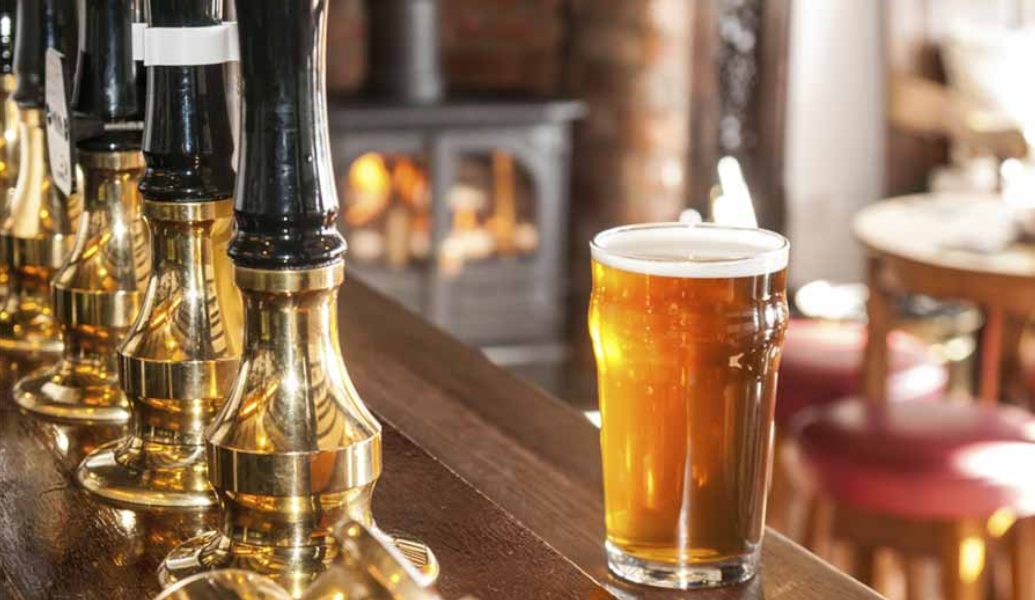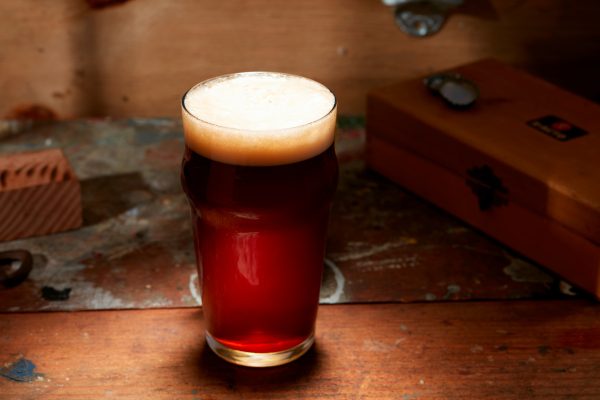By Jon Dura
I have been a homebrewer for over 20 years, and among my favorite beers to brew are British-inspired ales. Having traveled extensively in my business career, I’ve spent a good deal of time in the United Kingdom, where I was introduced to “real ale” by friends and colleagues. For the uninitiated, real ale in the UK refers to unpasteurized, cask-conditioned draught ale served without “extraneous CO2,” as opposed to pasteurized, filtered, pressurized, and chilled ale that comes in kegs.
This introduction to real ale opened my eyes to the fact that I had been generally missing the mark when it came to replicating British ales at home. The closest I came to real ale was in my early years when I was still bottle conditioning my beer, although I was definitely over-carbonating compared to the genuine article. When I began kegging, I would set my CO2 regulator to 2–3 pounds per square inch (140–200 mbar) and hope for the best. I was closer to the mark but not quite hitting it. It was only when I got a traditional English cask and actually cask conditioned my ale that I felt I was replicating what I had enjoyed in the UK.
Cask-conditioned ale is unpasteurized ale that is allowed to continue secondary fermentation in a cask, either by bunging the cask before fermentation finishes, or by adding priming sugar after final gravity has been reached. After secondary fermentation is complete, usually in one or two weeks, the cask is vented through a hole in the shive, a bung on the top of the cask, to release excess carbonation. The shive is sealed with a porous soft spile made of basswood to allow excess CO2 to vent while keeping the beer from gushing out of the shive and preventing air from entering the cask.
After the cask is vented, the soft spile is withdrawn and the cask is sealed with a less porous hard spile, usually made of hard wood or plastic, to seal the cask. The beer in the cask is served by literally tapping a spigot through a keystone on one end of the cask. That spigot may allow for gravity dispense, or it can be connected to a beer engine. Either way, the cask must allow gas in to replace beer as it is served.
That gas ingress is achieved in one of two ways. The first consists of withdrawing the hard spile completely or replacing the hard spile with a more porous soft spile. In this case, air will enter the cask as beer is drawn, and the beer is termed real ale. Alternatively, the cask may be fitted with a cask breather, which is a device that allows CO2 at atmospheric pressure to bleed into the cask as beer is served, thus keeping the beer from contacting air so that it does not spoil as quickly. According to the Campaign for Real Ale (CAMRA), beer served with a breather is not considered real ale.
A word about CAMRA is in order. In Britain, a campaign was launched by four concerned beer drinkers for the protection and reintroduction of cask-conditioned real ale. This small organization eventually grew to thousands and is considered to be one of the most successful grassroots organizations in the world. It is credited with the return of real ale, which was near extinction at the time, to the UK, where it is now a staple in the neighborhood pub, although perhaps not quite as popular as kegged ale and lager. Characteristic of real ale is the low carbonation, about 1.5 volumes of CO2 at 55°F (3 grams per liter at 13°C).
The problem with real ale from a homebrewer’s perspective is twofold. First, it spoils quickly, usually in the space of three or four days. Second, CAMRA has repeatedly denigrated the use of cask breathers, and many members of the British beer drinking public insist that air entering the cask actually improves the flavor of the ale. CAMRA has recently relaxed its stance on breathers and admits that they may be appropriate in pubs where turnover is not high enough to dispense an entire cask before it spoils, although they insist that the use of “extraneous CO2″ prevents such a cask from being considered “real.”
The Question
I had been wondering if CAMRA is right about cask breathers and, specifically, if there is any significant difference between traditionally dispensed ale, in which air enters the cask, and ale dispensed with the use of a CO2 breather. When the AHA started the Research and Education Fund (REF) [editor’s note: the REF is no longer operational], I suggested that this might be an area where research was warranted. The AHA Governing Committee agreed with me, and the following experiment was born.
The Experiment
To investigate this question, we decided that a blind tasting would be in order. All else being equal, the only difference in the tasting would be that the ale in question would be served under two conditions: one sample drawn from a traditional air-vented cask and one from a cask protected by a breather.
The Protocol
I decided on a middle-of-the-road best bitter. This beer should not be overly malty or hoppy, and neither should it be dry hopped so that the hop aroma would not obscure any significant aromas in the beer.
Because I wanted a single ale in the two casks—called pins, each of which holds 5.4 US gallons, 4.5 imperial gallons, or about 20 liters—I decided on a brew length of 12 US gallons (45 liters). I conducted a single large mash, a single boil of 90 minutes, and a single fermentation at 67°F (19°C) in a 16.5-gallon (62-liter) closed fermenter.
After initial fermentation was complete (about 7 days), I mixed 4 ounces (113 grams) of corn sugar into each of the casks as I filled them to capacity. I then allowed secondary fermentation to proceed at a constant 67°F (19°C) for ten days before allowing the casks to cool to cellar temperature of 53°F (12°C).
I vented the casks three days before the planned tasting. Unfortunately, a major snowstorm came in on the day of judging, so after much scrambling, we rescheduled for the following day (four days after venting the casks). About 24 hours prior to the tasting, I drew off 1.5 imperial gallons (7 liters) from each cask to ensure that the air-vented cask had enough time for air to mix with the ale to replicate the effects of a partially consumed cask. All was then ready for the tasting.
The Tasting & Results
First, I want to give a shout out to Andrew Hejl of the Keystone Hops Club for taking on the task of arranging the tasters. Although the original suggestion for the experiment was to have the beer tasted solely by judges, I thought having a mix of BJCP judges and some non-judges would provide an interesting perspective on what the average homebrewer would experience. This proved to be a fortuitous combination.
The panel consisted of four judges (it would have been a larger panel had the snowstorm not intervened); Andrew Hejl, Frank Pileggi, Brian Krebs, and Christopher Clair; and three non-judges; Brent Ziegler, Adam Juncosa, and Karen Malzone. I would like to thank them all for braving the elements and helping with the experiment.
To remove bias, tasters were not informed of the details of the experiment. The tasting was blind, and tasters only knew they were tasting two cask-conditioned best bitters. The judges in the group filled out BJCP scoresheets on the two samples, and everyone completed a survey indicating the differences that could be noted between the two samples and which sample they would prefer to drink.
Scoring was quite consistent among the four judges with Sample 1 (the air-vented cask) receiving an average score of 34.75, and Sample 2 (the cask with the breather) receiving an average score of 34.25. The score distribution was 33, 34, 36, and 36 for Sample 1 and 33, 34, 34, and 36 for Sample 2. The judges were split on which sample they preferred, with three preferring the air-vented cask and one preferring the breather-vented cask, although one judge stated in discussion that the differences between the two samples were very subtle.
For the non-judges, the split was different, with two preferring the breather cask (Sample 2) and one preferring the air-vented cask (Sample 1). This brings the air-vented cask to the top by a margin of 4 to 3.
As a kicker, I had my future son-in-law Joe Redlitz, who acted as a steward for the tasting, fill out one of the survey forms. His was definitely not blind, but as a typical beer drinker he preferred the breather cask because of its slightly higher carbonation.
Some of the remarks (paraphrased) from the scoresheets and surveys were:
- 1: more estery; 2: more bitterness, more hop aroma
- 1: more malt; 2: more estery, a little sweeter
- 1: more intensity of flavor, more hops, more estery 2: subdued hops, more one-dimensional
- 1: more estery, a bit watery; 2: more complex, better balanced
- 1: more hop forward aroma; 2: a bit astringent
- 2: sweeter, a bit more fruity aroma, better carbonation
- 1: slightly more heat and bitterness; 2: balanced
Conclusion
Although the air-vented cask was preferred 4 to 3 (4 to 4 if we include Joe’s opinion), the differences between the two were very slight, with judges siding with the air-vented cask and non-judges siding with the breather. The difference in the judges’ scoring was only 1.4 percent, hardly an overwhelming victory for the air-vented cask.
In conclusion, I would say that the average homebrewer would not be sacrificing much, if anything, by using a breather to extend the life of their cask-conditioned ale.







Share Post